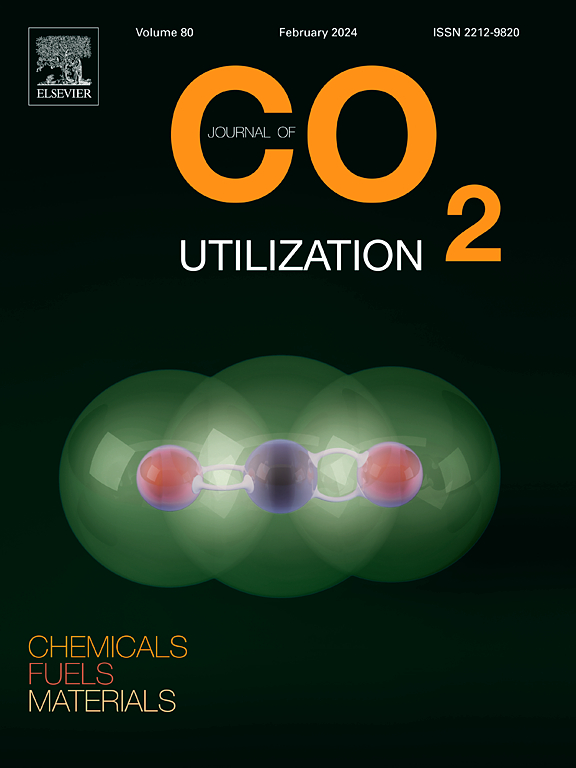Photocatalytic and surface consequences of thermal treatments on Pt nanoparticles onto carbon nitrides during CO2-to-CO conversion
IF 7.2
2区 工程技术
Q1 CHEMISTRY, MULTIDISCIPLINARY
引用次数: 0
Abstract
Photocatalysis is an emerging alternative to convert CO2 into relevant products, but it faces technological challenges related to charge recombination and low efficiency. Thermally coupled gas phase photocatalysis can address these issues by lowering reaction temperatures and improving process efficiency. This work demonstrates that defect engineering, combined with Pt impregnation at various metal dispersion and sizes, can enhance photocatalytic properties in g-C3N4 materials. Structural changes in g-C3N4 and Pt oxidation state modification, significantly impact CO productivity from CO2. This study investigates how thermal treatments in H2 affect defect and thus vacancy formation in g-C3N4. Materials with 2 wt% Pt2+ species generate C–N3 vacancies, while Pt0 species with the same content lead to both C–N3 and N–C3 vacancies– within g-C3N4. These differences exhibit distinct reaction trends under dark conditions or upon light irradiation. To further understand these effects, detailed XPS analyses clarify the impact of reaction conditions on the material after pretreatment and catalysis. The findings show that g-C3N4 materials can reform their C–Nbonds after electron excitation through light exposure, enhancing and stabilizing the reaction's productivity. As a result, CO productivities up to 1.1 mmol·gcat−1·h−1 are achieved. This work is expected to contribute to understanding the effect of thermal treatment on carbon nitrides, particularly regarding defect engineering, and more broadly, the effects of temperature in photocatalysis.
在二氧化碳转化为二氧化碳的过程中,对氮化碳上的铂纳米颗粒进行热处理的光催化效应和表面效应
光催化是将二氧化碳转化为相关产品的一种新兴替代方法,但它面临着与电荷重组和低效率有关的技术挑战。热耦合气相光催化技术可以通过降低反应温度和提高工艺效率来解决这些问题。这项研究表明,缺陷工程与不同金属分散度和尺寸的铂浸渍相结合,可以增强 g-C3N4 材料的光催化性能。g-C3N4 的结构变化和铂氧化态的改变会显著影响二氧化碳的 CO 产率。本研究探讨了 H2 中的热处理如何影响 g-C3N4 中的缺陷和空位形成。含有 2 wt% Pt2+ 物种的材料会产生 C-N3 空位,而相同含量的 Pt0 物种则会在 g-C3N4 中产生 C-N3 和 N-C3 空位。这些差异在黑暗条件下或光照下表现出截然不同的反应趋势。为了进一步了解这些影响,详细的 XPS 分析阐明了预处理和催化后反应条件对材料的影响。研究结果表明,g-C3N4 材料在光照射下受到电子激发后,其 C-N 键可以发生重整,从而提高并稳定了反应的生产率。因此,一氧化碳的生产率可达 1.1 mmol-gcat-1-h-1。这项研究有望帮助人们了解热处理对碳氮化物的影响,特别是缺陷工程方面的影响,以及更广泛的光催化过程中温度的影响。
本文章由计算机程序翻译,如有差异,请以英文原文为准。
求助全文
约1分钟内获得全文
求助全文
来源期刊

Journal of CO2 Utilization
CHEMISTRY, MULTIDISCIPLINARY-ENGINEERING, CHEMICAL
CiteScore
13.90
自引率
10.40%
发文量
406
审稿时长
2.8 months
期刊介绍:
The Journal of CO2 Utilization offers a single, multi-disciplinary, scholarly platform for the exchange of novel research in the field of CO2 re-use for scientists and engineers in chemicals, fuels and materials.
The emphasis is on the dissemination of leading-edge research from basic science to the development of new processes, technologies and applications.
The Journal of CO2 Utilization publishes original peer-reviewed research papers, reviews, and short communications, including experimental and theoretical work, and analytical models and simulations.
 求助内容:
求助内容: 应助结果提醒方式:
应助结果提醒方式:


